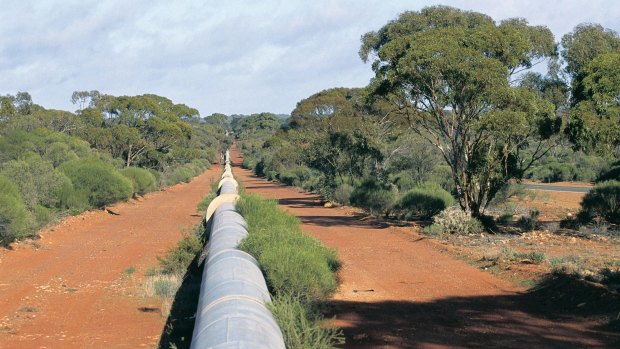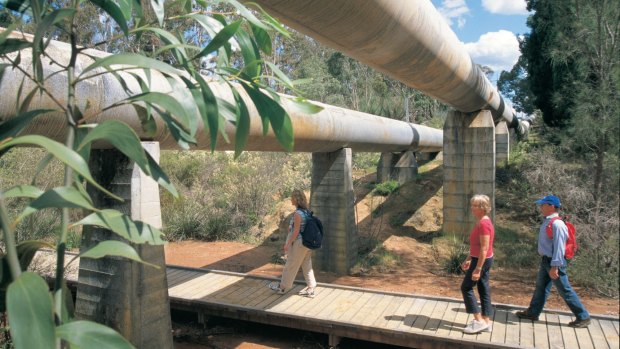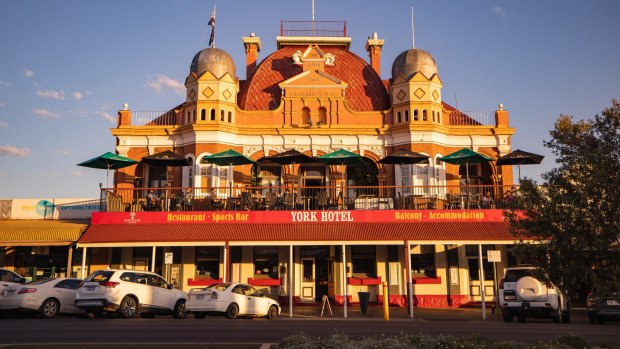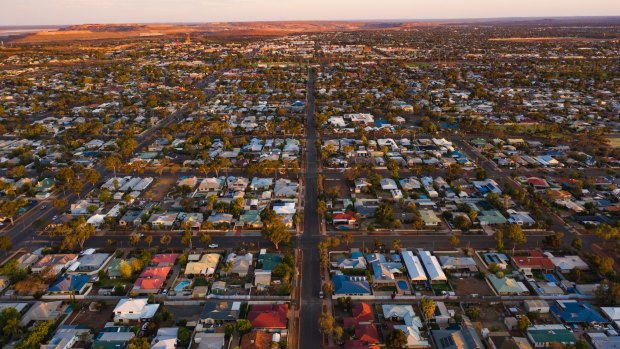This was published 2 years ago
The Golden Pipeline, WA (Kalgoorlie to Mundaring): How one pipe changed Australian history

The Golden Pipeline runs 569 kilometres from Perth to Kalgoorlie.Credit: Tourism WA
Mount Charlotte isn't about to attract climbing expeditions any time soon. At 419 metres above sea level, it is a mere landscape pimple, surrounded by the pockmarks of Kalgoorlie's gold mines.
It may not be impressive, but it is precious. The dull beige tank at the top provides the one thing – water - that's almost as valuable as gold. And the story of how the water got here, via what's now known as the Golden Pipeline, is remarkable.
When gold was found in the 1890s, Kalgoorlie quickly morphed into a boom town. But, with no rivers, an annual rainfall of 260 millimetres a year, and fast evaporation rates in the furnace-like outback heat, it was an extremely thirsty boom town.

It is an astonishing feat of engineering, for which its mastermind, C. Y. O'Connor, should receive far greater veneration than he does.Credit: Tourism WA
The Museum of the Goldfields brings home the scarcity. The rich would buy new clothes rather than washing them, because it was cheaper to do so. Fresh water was only used for cooking, and was more expensive than whisky or rum. People, and clothes, were only washed on Sundays and in brackish water from a government bore that was unfit for human consumption. People would queue up with any available containers they could find.
The system was very clearly unsustainable. Carting water in from hundreds of kilometres away by camel train could only ever be a temporary patch.
Enter C. Y. O'Connor, an Irishman, who via a posting in New Zealand, had risen to become Western Australia's Engineer-In-Chief. Work on his ambitious plan to build a harbour in Fremantle had already begun, and his next trick was to be even more of a stretch – a fresh water pipeline from reservoirs constructed in the Perth Hills.

The York Hotel on Hannan Street, Kalgoorlie. Gold turned Kalgoorlie into a boom town, but it had no fresh water.Credit: Tourism WA
That pipeline would have to travel 569 kilometres and climb 390 metres over the Darling Escarpment. It was an unprecedented project that many at the time deemed impossible. Its estimated cost was 2.5 million pounds – at the time, equivalent to the entirely colony of Western Australia's annual budget. It was a phenomenal gamble.
Leaving Kalgoorlie, the pipeline becomes a constant companion on the long, otherwise fairly tedious drive along the Great Eastern Highway to Perth. It's in full view, elevated above ground, and painted with special reflective paint to minimise loss from evaporation.
Every now and then, one of the pumping stations pops up in the sightline. They're grand, red brick affairs, brimming with industrial revolution elegance. But they're also sad, lonely and abandoned. Pulling over at the No. 6 Pump Station in Ghouli, the only sign of life is the 30 zillion flies intent on getting to eye sockets and earholes. A sign tells the tale of the families that once lived here, maintaining the station. But these days, flows are controlled remotely from Perth, with several booster stations having been installed along the route.

Around 100,000 people directly benefit from the pipeline, only 30,000 of whom live in Kalgoorlie (pictured).Credit: Tourism WA
A little further along at Burracoppin, the pipeline meets another epic stalwart of West Australian construction – the Rabbit Proof Fence. Fighting through those ever-present flies leads to a big memorial sign. It tells of how rabbits were introduced to Australia in 1859 by a Victorian grazier, who imported 24 bunnies for sport.
They soon multiplied, spreading across the continent, and advancing across the Nullarbor. In 1901, a Royal Commission decided that the way to protect Western Australia's crops and pastures was to build a big old fence. By the time the fence was completed in 1907, it stretched 3256 kilometres over three sections. The 1833 kilometre main section from Esperance to the Pilbara was the longest unbroken fence in the world.
By the 1950s, though, rabbit numbers had declined due to poisoning and disease. The bigger threat was emus migrating during droughts – in 1976, more than 100,000 emus lined up along the northern section of the fence, trying to break through. Today, the fence is known as the State Barrier Fence, and its primary purpose is to keep emus away from agricultural land.
In a neat synergy, much of the fence was built under the command of Richard John Anketell, who also built the reservoir at Mount Charlotte.
The end – or rather, the beginning – of the pipeline, comes in much prettier country. The Mundaring Weir in the Perth Hills is a bowl of deep blue surrounded by bushland. The No. 1 Pump Station – open at weekends to visitors – is here. Inside, displays explain how the system works. There's a network of interlinked reservoirs, and the Goldfields Water Supply Scheme is much expanded, with several extensions built to supply homes and farms across the Eastern wheatbelt. Around 100,000 people directly benefit from it, only 30,000 of whom live in Kalgoorlie. It is an astonishing feat of engineering, for which C. Y. O'Connor should receive far greater veneration than he does.
But O'Connor never lived to see his masterpiece finished. And the journey along the Golden Pipeline shouldn't end at Mundaring, but at South Beach in Fremantle. This was where, on March 10, 1902, O'Connor rode his horse into the shallows and shot himself.
This came after months of defamatory abuse from the press and politicians. His critics thought the whole scheme was corrupt, with O'Connor intending to funnel money to his friends and allies. At federalisation, his main backer, Sir John Forrest, left state politics to become federal minister for defence. O'Connor felt embattled, and in need of protection, his mental health deteriorating.
Eight months after O'Connor died, it was Forrest who turned on the taps amid great celebration at Mount Charlotte. The project worked, it came in on budget, and O'Connor was completely vindicated by a posthumous Royal Commission.
Today, a statue of the great forgotten engineer stands in Fremantle Port. But a far greater memorial to him is the pipeline, stretching 569 kilometres from the green hills to the inhospitable goldfields. And to drive along it is to salute a genius who came to a tragic end.
FIVE MORE THINGS TO DO IN KALGOORLIE
The Hannan's North Tourist Mine covers mining history, with mocked up prospectors' camps and enormous earth-moving equipment. Entry costs $15. See hannansnorth.com.au
Kalgoorlie Tours concentrates on modern gold mining, running tours to the deep cut Superpit on the city fringe. Those gigantic machines from Hannan's North? They're in action here, driving in a big spiral to the bottom of the pit. Tickets $60. See kalgoorlietours.com.au
The Two Up School, just outside city boundaries, is little more than a big, circular metal shed. It's one of the few places where the traditional Aussie gambling experience is legal outside of ANZAC Day. Spinners come in on Sundays only. See kalgoorlietourism.com/two-up-school
The Royal Flying Doctor Service Visitor Centre offers tours that show how the Flying Doctors provide medical assistance to the outback. Kalgoorlie is one of the RFDS' main bases. See flyingdoctor.org.au
The last two holes of the Nullarbor Links – the world's longest golf course, stretching all the way from Ceduna in South Australia – can be found at the Kalgoorlie Golf Course. See kalgoorliegolfcourse.com
TRIP NOTES
MORE
traveller.com.au/western-australia
FLY
Virgin Australia and Qantas fly to Kalgoorlie via Perth. See virginaustralia.com or qantas.com.au
Note: The WA border is currently closed to some states, while visitors from other states are required to quarantine. See here for details.
STAY
Solid, motel-style rooms at the Hospitality Kalgoorlie cost from $125. See bestwestern.com
Black marble, cockatoo wallpaper, free-standing baths and video art are all part of the chic mix at the QT Perth. Doubles from $194. See qthotelsandresorts.com
VISIT
Entry to the Museum of the Goldfields is free. See museum.wa.gov.au
It's $8 to get into the No. 1 Pump Station in Mundaring. See nationaltrust.org.au
TOUR
If driving solely from Kalgoorlie to Perth, one way charges ramp car hire fees up. Expect to pay from $133 a day with Thrifty. Thrifty.com.au
The writer travelled as a guest of Tourism Western Australia and QT Hotels.
Sign up for the Traveller Deals newsletter
Get exclusive travel deals delivered straight to your inbox. Sign up now.